A highlight for each class every year is the walking tour of Kilkenny
with Paddy Tynan of Tynan Walking
Tours. The tour aims to show a different aspect of the history of
the city each year. This year sixth class decided to focus on the main
historical sites in the city. Accordingly on Monday the 22nd of January,
2001 the class anxiously awaited the arrival of Paddy to begin our walking
tour. What follows is a photographic record and some brief history notes
compiled by the children.
|
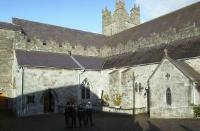
|
The Black Abbey
The Black Abbey was built in 1225. It was founded by
William Marshall. In 1543 it was suppressed by Henry VIII. It was
made into a courthouse when Cromwell came to Ireland in 1650. In 1866
it was reopened as a church. It is the only Dominican abbey in Ireland.
The Abbey gets its name from the fact that the priests wear black
over white robes. It is also known as the Abbey of the Holy Trinity.
|
 |
St.
Canice's Cathedral
St Canice's Cathedral, at the north side of the city,
is built on the site of an earlier church founded by St. Canice.
The tower was built in the 11th century. It is 99m high and was
used as a belfry and a refuge in times of danger. The cathedral
was begun by Hugh de Ross, continued by his successors, and competed
in 1285. When Cromwell came to Kilkenny he used St. Canice's as
a stable for his horses. |
|
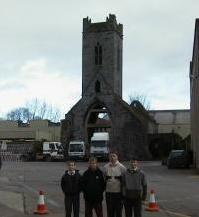
|
St.
Francis Abbey
The abbey was founded by Richard Marshall, Earl of
Pembroke in1234. The Black Death or plague, which spread through
Ireland in 1348, was recorded by John Glynn who was a friar in St.
Francis Abbey. A year later he died from the plague but he hadn't
finished his account. In 1650 Cromwell demolished the abbey into
ruins.
Smithwicks opened a brewery there in 1710 and it's
one of the oldest brewerys in Ireland. It is now owned by Guinness.
Guided tours are available each day during the summer. |
 |
The Court House (Grace's Old Castle)
In1566 James Grace handed it over to the people of
Kilkenny for use as a jail. The jail was used until 1920. In 1762
it became a courthouse. For stealing bread you could be sentenced
to3-4 years in jail. At least 4 people were in a cell.At least 100
prisoners were in there at any time. In 1830 some rebuilding took
place including the facade, balcony and the stone staircase.
|
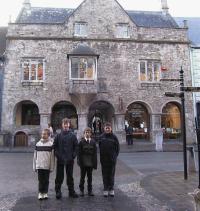 |
Rothe House
Rothe House is made up of three houses.The first house was built
in 1594.The second house was built in 1604. The third house was
built in 1610.The Rothes arrived in Ireland in about 1350 and gradually
becane very powerful.
Rothe House is the only Tudor style house left in Ireland. It
was the first house restored in Kilkenny. The third house is a ruin.
The first two houses have been set up as a library and information
centre. |
|

|
Kytler's Inn
Dame Alice Kytler was born in Kilkenny in1280. Her
father had a money lending business. When he died, Alice took over
the business. Alice married four times and was accused of poisoning
her husbands. She was accused of witchcraft by the Bishop of Ossory.
Alice, her son William and Petronella, a servant were put on trial.
Alice escaped to England, Petronella was burned and William was
pardoned when he promised to re-roof part of St. Canices Cathedral.
We know nothing of Alice after that. |
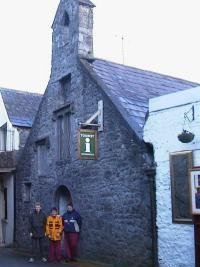 |
Shee Alms House
Shee Alms House was first owned by the church.
The Shee family originally came from Kerry.
Richard Shee was a lawyer. He bought the house and he used it to
care for twelve homeless people. The Shee family kept the poor people
in care and shelter for 150 years.
In 1752 the house was sold. The house was restored
in 1978. It is a priceless Tudor style building. It is situated
in Rose Inn Street. The house is now a tourist office. |
 |
The Town Hall - Tholsel
The Tholsel was a house of taxes. It was built by
the Colle family in 1761. The architect is unknown. The total cost
of the building was £1,315. It was restored in 1949 for £49,000.
In the municipal archives there is a fine collection of records,
minute books and charters including the Great Charter of 1609 which
elevated Kilkenny to the status of a city, and the Liber Primus.
The first book of records dates back to 1230 A.D. The sword (1609)
and the mace (1677) are very impressive. |
 |
Kilkenny Castle
Earl Marshall started to build the castle in 1192.
In 1391 the Butler family moved into the castle. They left in 1935.
The castle had 55 acres of land. It was sold to the public for the
small sum of £50. It was taken into state custody in the year
1965. £5 million has been spent on the castle and now it has
beautiful gardens and a childrens playground. The Butlers are buried
in the castle with their dog Sandy. Kilkenny Castle is a great tourist
attraction. |
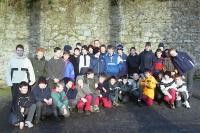 |
An rang agus Paddy
Tynan ag balla an chaisleáin agus iad tar-éis an-taitneamh
a bhaint as an turas. Ar ais ar scoil, bhí comórtas
ealaine ag na páisti agus seo a leanas cuid de na h-irrachtaí.
Beidh an rang ag tabhairt faoi thuras amháin eile roimh deireadh
na bliana agus tá siad ag súil go mór le sin. |
| |
|
 |
|
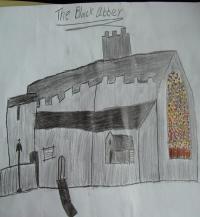 |
|
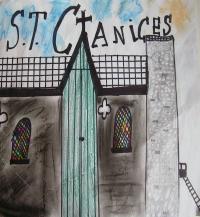 |
|




